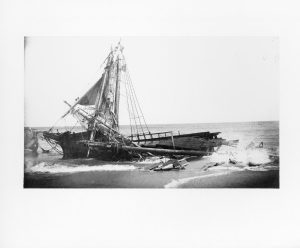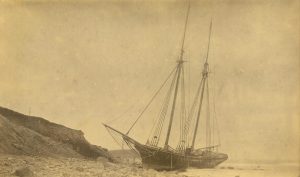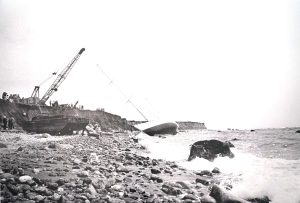
Hunting, gathering, fishing, foraging … early colonists of Montauk took full advantage of the prolific wildlife, but they also did some scavenging on the side.
Notwithstanding potentially tragic human loss, shipwrecks provided a big boost to the local economy. Locals used salvaged timber to build fences and fill fireplaces. “Every year about 2,000 loads of wood washed from wrecks, furnishing Montauk people with all the fuel they needed,” a visitor claimed as late as 1892. (Beginning around 1895, railroad workers also tossed coal to the villagers on Fort Pond Bay to heat their homes.)
“People who lived near the beach would watch the weather, and figure carefully about when anything was likely to wash up on the beach; so that they could be first on the spot to look it over,” Jeannette Edwards Rattray wrote in Montauk: Three Centuries of Romance, Sport and Adventure. “The custom was, for the finder of a ship’s spar, or anything too big to carry home by hand, to initial it. Then nobody else would touch it, while the early bird went home to get his horse and farm wagon.”



Cargo ships navigating the treacherous shore of the Point transported an almost unfathomable variety of goods.
“Among the various items cast up by the sea and enjoyed by the inhabitants – in addition to timber and handsome young men – have been Spanish gold pieces, fruit from Spain and Italy …, cocoanuts, peanuts, choice liquor from France, trees and shrubs, ostrich eggs, Maltese cats, masts that were turned into village flagpoles, shoes, and calico,” Mrs. Rattray wrote in another book, Ship Ashore!

Legend has it that the first tea kettle in East Hampton Town came ashore from an 18th-century shipwreck off Montauk. “Farmers at Montauk could not imagine the use of the teakettle; some said one thing, some another,” Mrs. Rattray wrote. “Finally they carried it to East Hampton and put the question to old ‘Governor’ Samuel Hedges, as the wisest man in the village. He decided it was the ship’s lamp, and all agreed.”
The author went on to explain that it took some time before tea came into general use on Long Island, noting that at first “one family … boiled it in a pot and ate it like samp porridge” while one individual “spread the leaves on bread and butter, and boasted to his neighbors of having eaten a half-pound at a meal.”
Montauk scavengers also sprang into action after the “Lewis A. King” was wrecked near Montauk Point after the captain lost his bearings. No one was hurt, but the captain was unwilling to pay the price asked by the wrecking company, so the vessel sat, ignored, for some two years before finally breaking apart. Not so her cargo of dates and pipe clay, however. “The dates, in 300-pound sacks, were salvaged, and date pudding was a favorite dessert in eastern Long Island for many months,” according to Ship Ashore!
A similarly flavorful tale is told about the “Elsie Fay,” which wrecked in a snowstorm in 1893 carrying logwood and coconuts. The latter bobbed their way to land, “much to the delight of Montauk residents, who had coconuts in every style for about a year,” Mrs. Rattray wrote. They came ashore near the Point in a cove today known as Coconuts.
Then there is the matter of the “George Appold,” a freight and passenger steamer that wrecked at Montauk in 1889.
“The ‘Appold’ carried one hundred barrels of New England rum, a great quantity of calico in ugly colors, some rather coarse clothing, and heavy, cheap shoes,” according to Ship Ashore! “Farm wagons came to Montauk from Amagansett and the nearby Hamptons to share in whatever might wash ashore.”
“Thrifty mothers wore house dresses, aprons, and sunbonnets for years, made from a certain chocolate-brown calico with white rings on it, or another pattern in red and yellow; and made it into little girls’ school dresses. Elderly women today recall with tears in their eyes how they loathed those dresses, made of ‘Appold’ calico.”
“There was a great time matching up the shoes. Children hated to wear them, because their copper toes marked them as ‘wreck shoes.’”


Reply or Comment